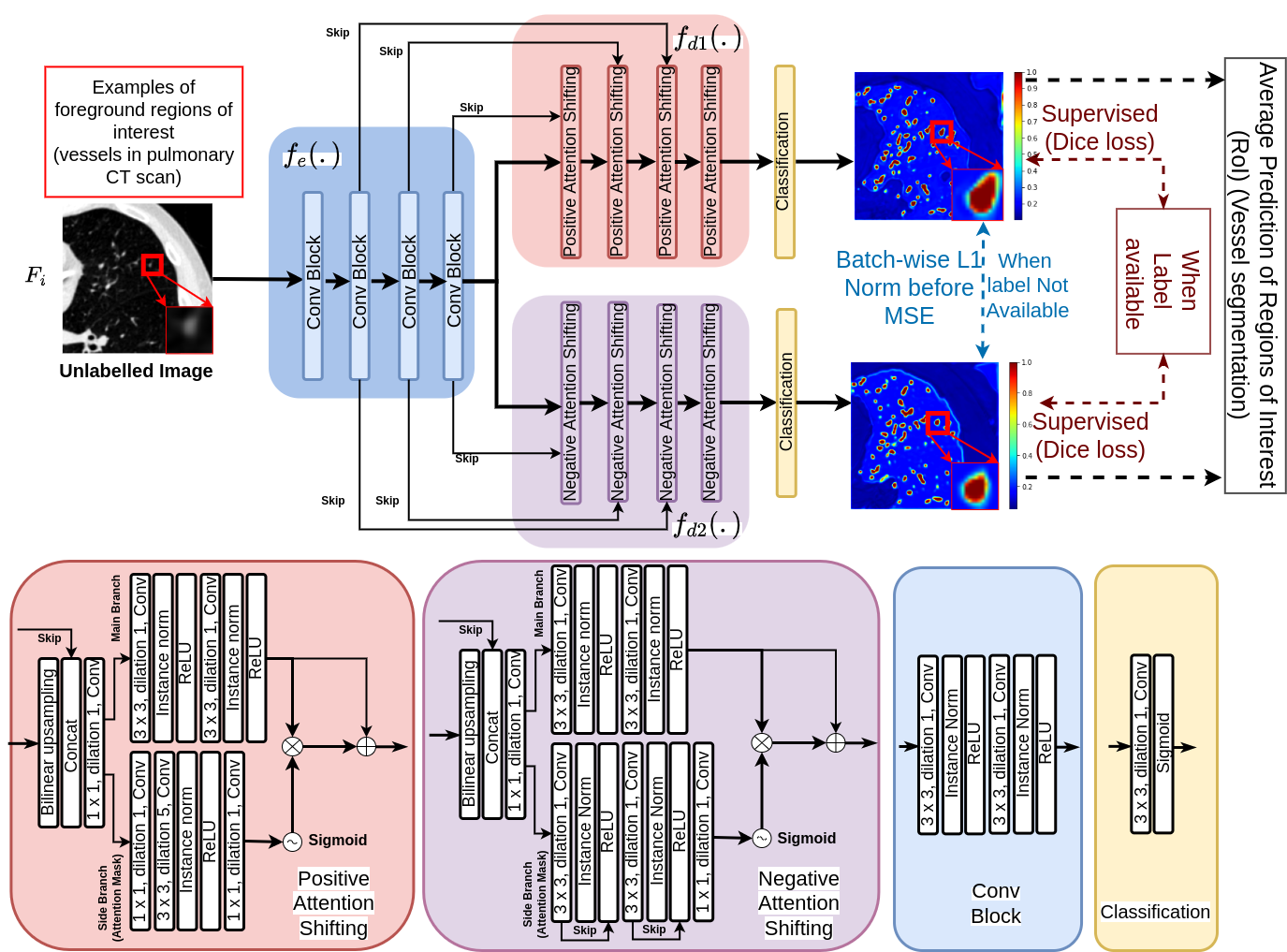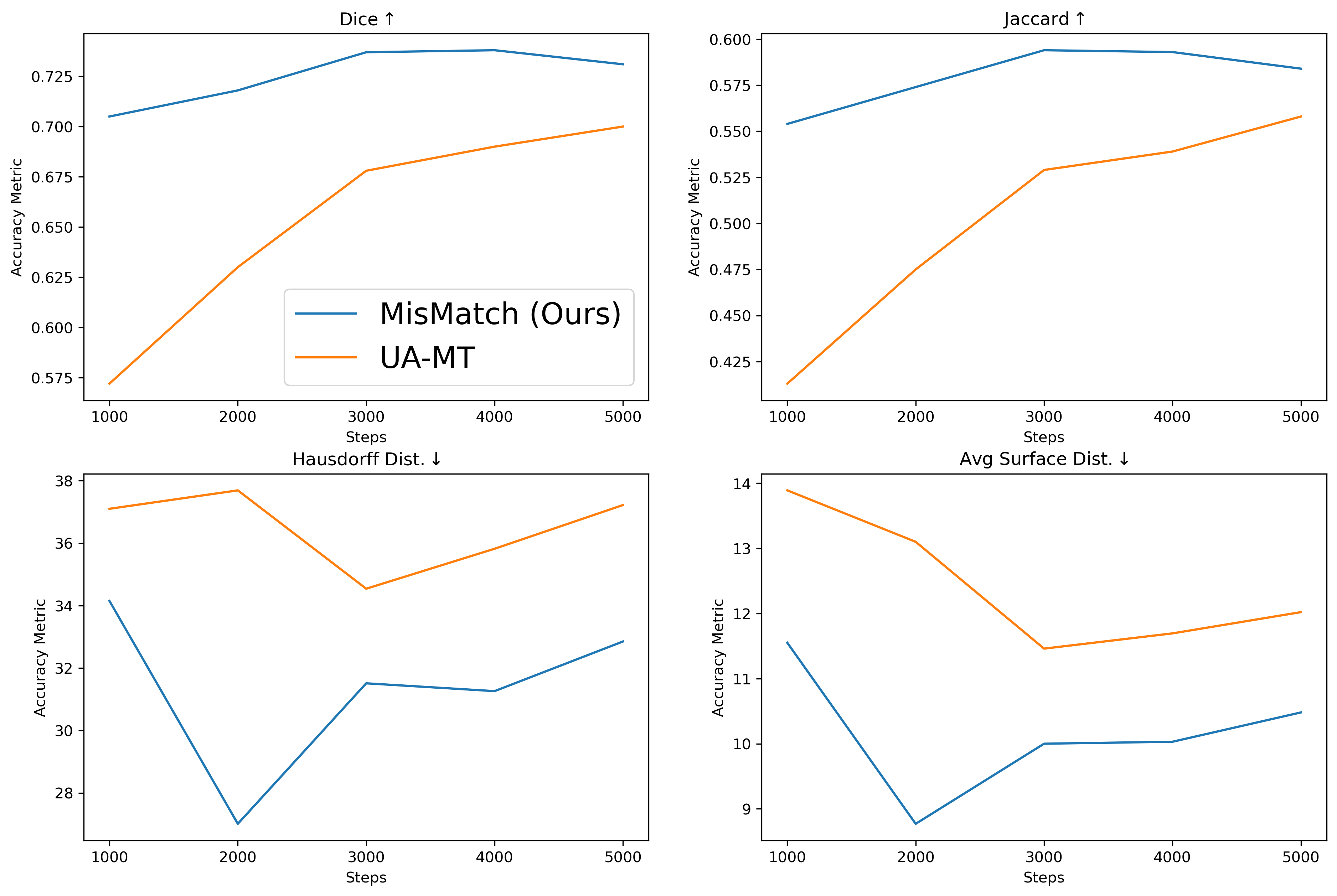News
[2022 May 30th] Happy to announce that our paper got accepted at MIDL 2022 as an oral presentation (top 11.6%)
[2023 Sep 15th] We release a new 3D version of our implementation based on a new 3D dataset of left atrium and the extended version is published as a journal paper at IEEE TMI (impact factor 11): https://ieeexplore.ieee.org/stamp/stamp.jsp?tp=&arnumber=10121397
Summary
This repository is an implementation of the MIDL2022 paper: 'Learning Morphological Feature Perturbations for Calibrated Semi-Supervised Segmentation' and the IEEE TMI paper 'MisMatch: Calibrated Segmentation via Consistency on Differential Morphological Feature Perturbations With Limited Labels'. This code base was written and maintained by Moucheng Xu
Introduction
Consistency regularisation with input data perturbations in semi-supervised classification works because of the cluster assumption. However, the cluster assumption does not hold in the data space in segmentation (https://arxiv.org/abs/1906.01916). Fortunately, the cluster assumption can be observed in the feature space for segmentation. Therefore, we propose to use consistency regularisation on feature perturbations for semi-supervised segmentation and we propose to learn feature perturbations end-to-end with network architecture manipulations based on differential morphological operations.
Our Contributions and Method:
- We provide a new interperation of ERF (effective receptive field: https://arxiv.org/abs/1701.04128) as a theoretical foundation for incorporating differential morphological operations of features in neural networks;
- Based on our insight on the connection between ERF and morphological operations, we build a new encoder-decoder network architecture of semi-supervised segmentation with two decoders:
- positive attention decoder which enforces inductive bias to do differential dilation operations on the features;
- negative attention decoder which enforces another inductive bias to do differential erosion operations on the features.
- We then apply l1 normalisation along batch dimension on the two outputs which come from the dilaiton decoder and the erosion decoder respectively before we apply a consistency loss.
 See our paper (https://arxiv.org/pdf/2110.12179.pdf) for more details.
See our paper (https://arxiv.org/pdf/2110.12179.pdf) for more details.
Hyper-Parameters of experiments on the LA dataset
| LR | Batch | Seed | Width | Consistency | Labels | Steps |
|---|---|---|---|---|---|---|
| 0.01 | 4 | 1337 | 8 | 1 | 2 | 5000 |
Results on the LA dataset between consistency on feature perturbations (Ours) and consistency on data perturbations (UA-MT)
| Models (5000 steps) | Dice (⬆) | Jaccard (⬆) | Hausdorff Dist. (⬇) | Average Surface Dist. (⬇) |
|---|---|---|---|---|
| MisMatch (Ours) | 0.73 | 0.58 | 32 | 10 |
| UA-MT | 0.70 | 0.55 | 37 | 12 |
Installation and Usage
This repository is based on PyTorch 1.4. To use this code, please first clone the repo and install the anaconda environments via:
git clone https://github.com/moucheng2017/Morphological_Feature_Perturbation_SSL
cd MisMatchSSL
conda env create -f midl.yml
To train the baseline on LA with default hyperparameters:, use:
cd MisMatchSSL/code # change directory to your working directory where you downloaded the github repo
python train_LA_meanteacher_certainty_unlabel.py To train our proposed model MisMatch on LA with default hyperparameters, use:
cd MisMatchSSL/code # change directory to your working directory where you downloaded the github repo
python train_LA_mismatch.py To train the models on other custom datasets or the lung tumour or the brain tumour, you have to first prepare your datasets following:
--labelled/
-- imgs/
-- some_case_1.nii.gz
-- some_case_2.nii.gz
-- ...
-- lbls/
-- some_case_1.nii.gz
-- some_case_2.nii.gz
-- ...
--unlabelled/
-- imgs/
-- some_case_5.nii.gz
-- some_case_6.nii.gz
-- ...
--test/
--imgs/
-- some_case_7.nii.gz
-- some_case_8.nii.gz
-- ...
--lbls/
-- some_case_7.nii.gz
-- some_case_8.nii.gz
-- ...
To train our model on your own datasets, please use the following template, but do remember to change the data directory, if you set up "witdh" as 8 and cropping size at 96 x 96 x 96 (default in the training code, but in config), then a 12GB GPU should be enough:
cd MisMatchSSL/code # change directory to your working directory where you downloaded the github repo
python train_3D_mismatch.py \
--root_path '/directory/to/your/datasets/Task01_BrainTumour' \
--exp 'MisMatch_brain' \
--max_iterations 6000 \
--batch_size 4 \
--labeled_bs 2 \
--base_lr 0.001 \
--seed 1337 \
--width 8 \
--consistency 1.0Citation
If you find our paper or code useful for your research, please consider citing:
@inproceedings{xmc2022midl,
title={Learning Morphological Feature Perturbations for Calibrated Semi-Supervised Segmentation},
author={Xu, Moucheng and Zhou, Yukun and Jin, Chen and deGroot, Marius and Wilson Frederick J. and Blumberg, Stefano B. and Alexander, Daniel C. and Oxtoby, Neil P. and Jacob, Joseph},
booktitle = {International Conference on Medical Imaging with Deep Learning (MIDL)},
year = {2022} }
Note for the LA data we used:
The left atrium processed h5 dataset is in the data folder. You can refer the code in code/dataloaders/la_heart_processing.py to process your own data. If you use the LA segmentation data, please also consider citing:
@article{xiong2020global,
title={A Global Benchmark of Algorithms for Segmenting Late Gadolinium-Enhanced Cardiac Magnetic Resonance Imaging},
author={Xiong, Zhaohan and Xia, Qing and Hu, Zhiqiang and Huang, Ning and Vesal, Sulaiman and Ravikumar, Nishant and Maier, Andreas and Li, Caizi and Tong, Qianqian and Si, Weixin and others},
journal={Medical Image Analysis},
year={2020} }
Note for the other two 3D datasets we used:
The lung (Task_06) and brain tumour (Task_01) datasets are downloaded from the http://medicaldecathlon.com/
Questions
Please contact 'xumoucheng28@gmail.com'
Ackwnoledgement
Massive thanks to my amazing colleagues including Yukun Zhou, Jin Chen, Marius de Groot, Fred Wilson, Neil Oxtoby, Danny Alexander and Joe Jacob. This code base is built upon a previous public code base on consistency on data space perturbations: https://github.com/yulequan/UA-MT
